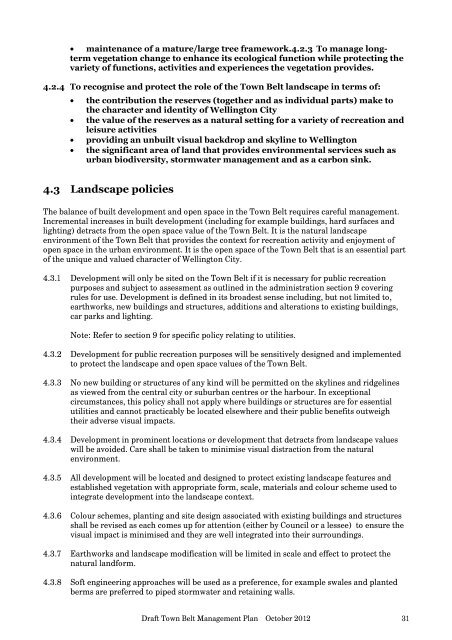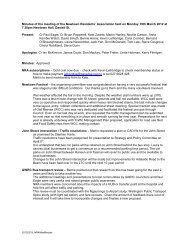Draft Town Belt Management Plan - Wellington City Council
Draft Town Belt Management Plan - Wellington City Council
Draft Town Belt Management Plan - Wellington City Council
You also want an ePaper? Increase the reach of your titles
YUMPU automatically turns print PDFs into web optimized ePapers that Google loves.
• maintenance of a mature/large tree framework.4.2.3 To manage longterm<br />
vegetation change to enhance its ecological function while protecting the<br />
variety of functions, activities and experiences the vegetation provides.<br />
4.2.4 To recognise and protect the role of the <strong>Town</strong> <strong>Belt</strong> landscape in terms of:<br />
• the contribution the reserves (together and as individual parts) make to<br />
the character and identity of <strong>Wellington</strong> <strong>City</strong><br />
• the value of the reserves as a natural setting for a variety of recreation and<br />
leisure activities<br />
• providing an unbuilt visual backdrop and skyline to <strong>Wellington</strong><br />
• the significant area of land that provides environmental services such as<br />
urban biodiversity, stormwater management and as a carbon sink.<br />
4.3 Landscape policies<br />
The balance of built development and open space in the <strong>Town</strong> <strong>Belt</strong> requires careful management.<br />
Incremental increases in built development (including for example buildings, hard surfaces and<br />
lighting) detracts from the open space value of the <strong>Town</strong> <strong>Belt</strong>. It is the natural landscape<br />
environment of the <strong>Town</strong> <strong>Belt</strong> that provides the context for recreation activity and enjoyment of<br />
open space in the urban environment. It is the open space of the <strong>Town</strong> <strong>Belt</strong> that is an essential part<br />
of the unique and valued character of <strong>Wellington</strong> <strong>City</strong>.<br />
4.3.1 Development will only be sited on the <strong>Town</strong> <strong>Belt</strong> if it is necessary for public recreation<br />
purposes and subject to assessment as outlined in the administration section 9 covering<br />
rules for use. Development is defined in its broadest sense including, but not limited to,<br />
earthworks, new buildings and structures, additions and alterations to existing buildings,<br />
car parks and lighting.<br />
Note: Refer to section 9 for specific policy relating to utilities.<br />
4.3.2 Development for public recreation purposes will be sensitively designed and implemented<br />
to protect the landscape and open space values of the <strong>Town</strong> <strong>Belt</strong>.<br />
4.3.3 No new building or structures of any kind will be permitted on the skylines and ridgelines<br />
as viewed from the central city or suburban centres or the harbour. In exceptional<br />
circumstances, this policy shall not apply where buildings or structures are for essential<br />
utilities and cannot practicably be located elsewhere and their public benefits outweigh<br />
their adverse visual impacts.<br />
4.3.4 Development in prominent locations or development that detracts from landscape values<br />
will be avoided. Care shall be taken to minimise visual distraction from the natural<br />
environment.<br />
4.3.5 All development will be located and designed to protect existing landscape features and<br />
established vegetation with appropriate form, scale, materials and colour scheme used to<br />
integrate development into the landscape context.<br />
4.3.6 Colour schemes, planting and site design associated with existing buildings and structures<br />
shall be revised as each comes up for attention (either by <strong>Council</strong> or a lessee) to ensure the<br />
visual impact is minimised and they are well integrated into their surroundings.<br />
4.3.7 Earthworks and landscape modification will be limited in scale and effect to protect the<br />
natural landform.<br />
4.3.8 Soft engineering approaches will be used as a preference, for example swales and planted<br />
berms are preferred to piped stormwater and retaining walls.<br />
<strong>Draft</strong> <strong>Town</strong> <strong>Belt</strong> <strong>Management</strong> <strong>Plan</strong> October 2012 31





